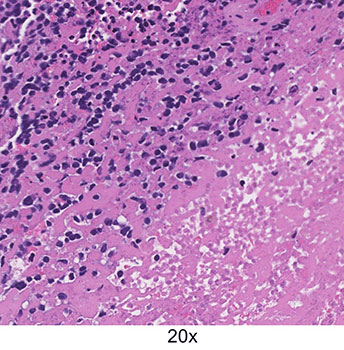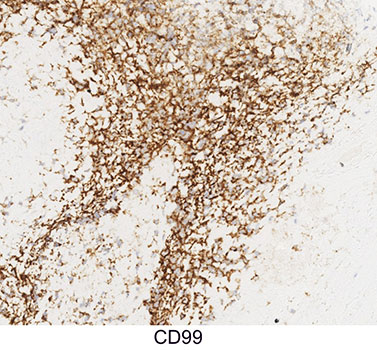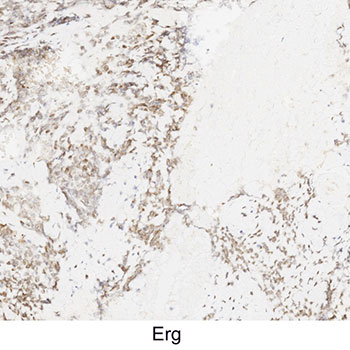June 2022 – Presented by Dr. Anupam Mitra (Mentored by Dr. Kurt Schaberg)
A 15-year-old female presented with recurrent swelling of the left vulva for last 16 months. Patient first noticed a small painless swelling over the left vulva while she was taking shower back in late 2020. Few months later she felt pain over the swelling after riding a horse. No history of trauma present. On clinical evaluation, the swelling appeared to be a hematoma. Drainage of the hematoma provided symptomatic relief. Few months after this incidence, patient felt that the vulvar swelling increased in size and this time it is much bigger (size of a duck egg). Imaging study suggested a soft tissue tumor arising in the vulva. A biopsy was performed. Patient does not have any known family history of any malignancy
Multiple fragments of pink soft tissue aggregating to 2.0 x 1.0 x 0.1 cm was received and entirely submitted.
Histologic evaluation of the tissue revealed marked tissue necrosis with clusters of uniform small blue cells. No cytologic atypia or nucleoli noted. Mitosis are absent. Green arrow indicates small round blue cells and red arrow indicates necrosis).


Morphologically this finding raises the differential of small round blue cells tumor which includes Lymphoma/leukemia, Wilms tumor, Ewing Sarcoma, Ewing-like Sarcomas (ex. CIC-rearranged sarcoma, BCOR-rearranged sarcoma), Rhabdomyosarcoma, Neuroblastoma and Desmoplastic round cell tumor. To distinguish between these differentials, a panel of immunohistochemical stains were performed. Briefly, small blue cells in this case showed diffuse membranous CD99 positivity and patchy Erg positivity. Other immunohistochemical stains (AE1/AE3, EMA, CD45, TdT, CD34, Desmin, Myogenin, WT-1, SATB2, Synaptophysin and S100) were all negative.


Based on the morphology and immunohistochemical staining pattern, most likely this is a case of extra-skeletal Ewing Sarcoma of vulva. To confirm the diagnosis, tissue was sent for FISH study which came back positive for the specific translocation of Ewing Sarcoma.

 Meet our Residency Program Director
Meet our Residency Program Director
